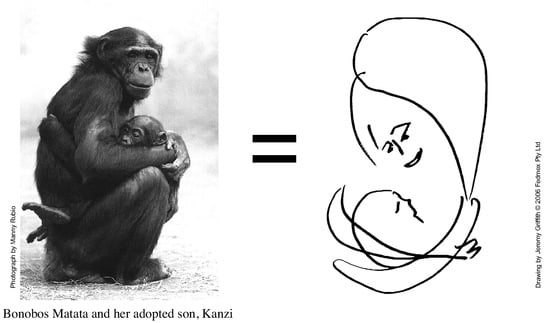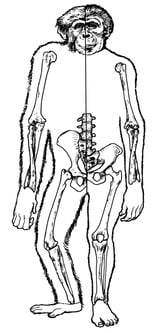‘FREEDOM’—Chapter 8 The Greatest, Most Heroic Story Ever Told
Chapter 8:3 INFANCY
The genus: our early ape ancestors, including Ardipithecus — 12 to 4 million years ago
The individual now: 0 to 3 years old
As explained in chapter 5, it was through the process of love-indoctrination, the exceptional nurturing of infants, that our ape ancestor was able to develop unconditionally selfless, fully altruistic, cooperative, moral, integrative, Specie Individual-forming behaviour—a process the bonobos are currently perfecting, as illustrated by the above photo of the bonobo Matata hugging her adopted son, Kanzi. Nurturing is what made us human, a truth the image of the Madonna and child has been the archetypal representation of. And, as was explained in chapter 7:3, with the development of selflessness consciousness was able to emerge, and with consciousness came all the stages of maturation that consciousness itself had to progress through—namely infancy, childhood, adolescence, and adulthood. (It should be mentioned that while the main stages of maturation in non-human species are generally described as infancy, then adolescence when individuals are on the threshold of sexual maturity, and finally the sexual maturity of adulthood, in the case of fully conscious humans our stages of maturation involve a psychological journey, so our stages of maturation—from infancy to childhood, adolescence and finally adulthood—are fundamentally different to the infancy, adolescence and adulthood stages of other species.)
As stated, the first stage of infancy occurs when humans become sufficiently conscious, sufficiently aware of cause and effect to realise that ‘I exist’; it is when we realise that we are at the centre of constantly changing experiences. This emerging consciousness and resulting self-awareness is apparent in bonobos who are the most intelligent of all non-human primates; indeed, some of that intelligence is apparent in Matata’s expression. Yes, as was explained and evidenced in pars 426-429 and 693-694, bonobos are ‘the most intelligent of all the great apes’; and ‘Everything seems to indicate that Chim [a bonobo] was extremely intelligent. His surprising alertness and interest in things about him bore fruit in action, for he was constantly imitating the acts of his human companions and testing all objects. He rapidly profited by his experiences…Never have I seen man or beast take greater satisfaction in showing off than did little Chim. The contrast in intellectual qualities between him and his female companion [a chimpanzee] may briefly, if not entirely adequately, be described by the term “opposites”’; and, ‘“It’s like being with 9 two and a half year olds all day,” she [zoo keeper Barbara Bell] says. “They’re extremely intelligent…They understand a couple of hundred words,” she says. “They listen very attentively. And they’ll often eavesdrop. If I’m discussing with the staff which bonobos (to) separate into smaller groups, if they like the plan, they’ll line up in the order they just heard discussed. If they don’t like the plan, they’ll just line up the way they want.” “They also love to tease me a lot,” she says. “Like during training, if I were to ask for their left foot, they’ll give me their right, and laugh and laugh and laugh. But what really blows me away is their ability to understand a situation entirely.”’
As was explained in detail in chapter 5:5, recently published reports on the ‘Infantman’ fossils, Sahelanthropus, Orrorin and Ardipithecus, provide powerful validation of the love-indoctrination process, and also confirm that ‘Infantman’ closely resembled bonobos in many important respects. To briefly reiterate, there are, as has been emphasised, three main requirements for the nurturing-of-infants, love-indoctrination process to take place—upright walking, or bipedalism; ideal nursery conditions; and the presence and influence of more maternal mothers—and these fossil discoveries now show that at least as far back as 7 million years ago our ancestors were adapted to walking upright, as are bonobos, who walk upright more often than any other non-human primate. With regard to ideal nursery conditions, these fossils also confirm that ‘Infantman’ lived in forests and woodlands, not savannahs, and was semi-arboreal like the bonobos, who are the most arboreal of the African apes. Importantly, with regard to the need for more maternal mothers, it was also described in chapter 5:5 that the fossil record now strongly suggests that ‘Infantman’ lived in a cooperative society that was characterised by female sexual selection for less aggressive males, indicating a matriarchal society, which is consistent with a society where the raising of infants had become the central focus, as it is with bonobos. Based on these fossil finds, the anthropologist C. Owen Lovejoy reinforced both the reality and the duration of our cooperative past, writing that ‘Even our species-defining cooperative mutualism can now be seen to extend well beyond the deepest Pliocene [well beyond 5.3 million years ago]’ (‘Reexamining Human Origins in Light of Ardipithecus ramidus’, Science, 2009, Vol.326, No.5949).
Left side: Bonobo skeleton. Right side: Early australopithecine, Australopithecus afarensis, ‘Lucy’, skeleton.
Drawing by Adrienne Zihlman from ‘Pygmy chimps, people, and the pundits’, New Scientist, 15 Nov. 1984.
A comparative look at the physique of bonobos and the fossil evidence provided by ‘Lucy’, the 3.5-million-year-old ‘Childman’, Australopithecus afarensis, who was discovered in the Rift Valley of Africa in 1974 by a team headed by the paleoanthropologist Donald Johanson, is also informative, as Lucy’s bone structure shows an amazing similarity to that of a bonobo. While Lucy’s skull indicates she had a slightly larger brain than a bonobo, the two are very similar in stature and in the length of the lower limbs, and are fairly similar in overall body proportions. Lucy’s pelvis shows that she walked fully upright. The pelvis of a bonobo, while not quite as adapted to bipedalism/upright walking as Lucy’s, is significantly more adapted than that of a chimpanzee. Incidentally, ‘Infantman’ Ar. ramidus, who it has already been shown is at a stage of development comparable to that of the bonobo (recall Frans de Waal’s observation that ‘The bonobo’s body proportions—its long legs and narrow shoulders—seem to perfectly fit the descriptions of Ardi, as do its relatively small canines’), has a brain volume measuring between 300 and 350cc, which is the same size as a bonobo.
In summary, the fossil record is now providing clear evidence that love-indoctrination had been established in ‘Infantman’ at least as far back as 7 million years ago, and this time frame will no doubt increase as more fossils emerge. The fossils also evidence that in bonobos, the most conscious and intelligent of the great apes, we have a living comparison of our ‘Infantman’ ancestor on the verge of ‘Childman’.




